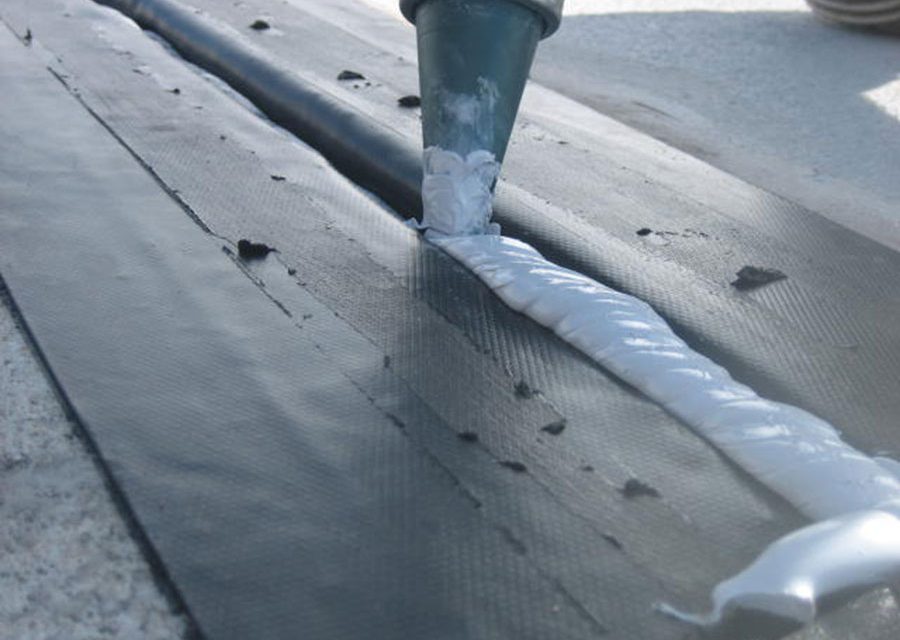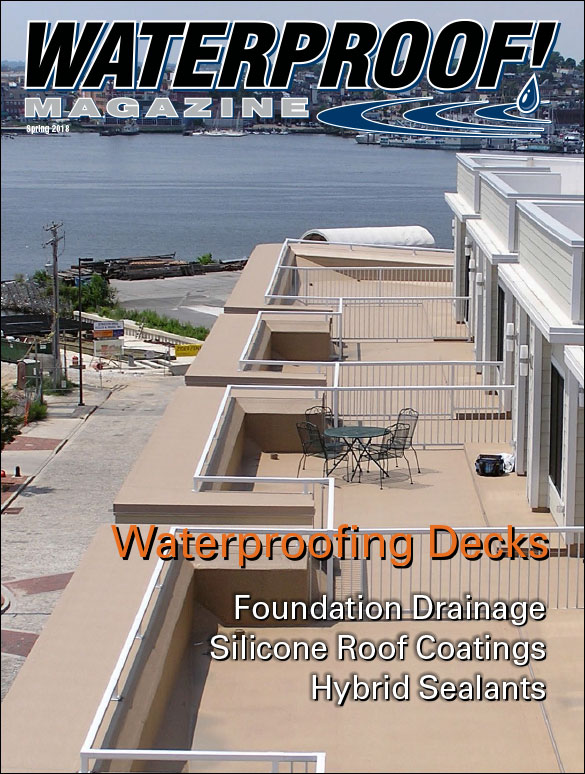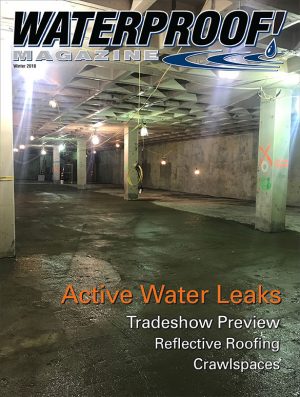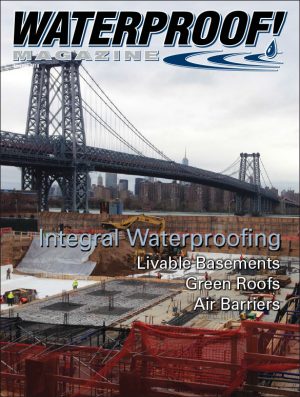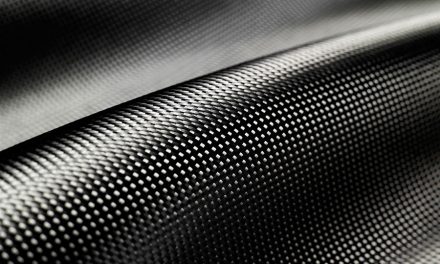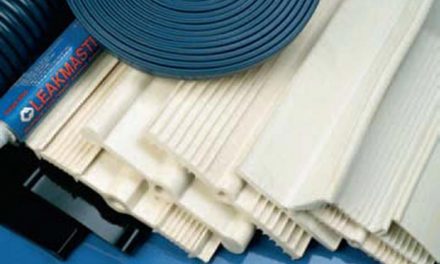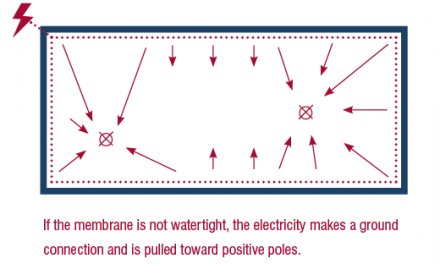Hybrid sealants are gaining popularity due to various performance properties. Here, a hybrid sealant is being used to seal a large expansion joint.
For years, the most commonly used sealants and caulks in the commercial building industry included urethanes, solvent-based silicones and acrylics. For the most part, those types of sealants performed as expected, keeping air, water, insects and dust out of buildings at windows or gaps in walls or joints. Although they have long been trusted in the industry due to their history, traditional solvent-based sealants have several drawbacks, including shrinking, cracking due to UV exposure, odor, high solvents, and lack of long-term UV stability and flexibility. A new technology that combines the best properties of urethanes and silicones has emerged and is beginning to make headway in the industry due to its environmentally friendly properties and superior performance. Hybrid sealants can be applied anywhere traditional sealants can be applied and even offer additional application versatility, such as adhesion over Kynar coated surfaces or over residual silicone-based products.
Additional benefits of hybrid sealants include:
- Mechanical endurance
- Environmentally friendly
- Little to no odor
- High solid content which eliminates shrinking
- High elongation
- UV stability which eliminates cracking
- Paintable surface within hours instead of days
- What Are Hybrid Sealants?
Hybrid sealants are best defined as a fusion of technologies – the best performance properties of urethanes combined with the best of silicones. And in that fusion process, their inherent weaknesses are limited. Urethane and silicone sealants are often referred to as high-performance sealants because they provide significant adhesion, movement capability and durability. Hybrid sealants combine the strength of polyurethanes with the weathering resistance of silicones to create a high-performance, functionally versatile sealant.
Hybrid sealants are gaining in popularity due to their solvent-free and isocyanate-free nature as well as their flexibility and adaptability. Hybrid sealants bond with most construction materials such as concrete, stone, wood, metal, plastic, polycarbonate, ceramic tiles and gypsum boards. They also bond well with porous surfaces.
Most hybrid sealants contain very small amounts of Volatile Organic Compounds (VOCs) or none at all, allowing them to be used on projects at odor sensitive facilities such as hospitals, schools and offices without causing major disruption to operations. Each year, VOC regulations get more and more stringent. A 2015 report from the International Sanitary Supply Association confirms that more states are issuing VOC limitations, and states with existing limitations are expanding the reach of their regulations as well as issuing more aggressive restrictions for existing product categories, which in part, has driven the development of this new technology.
Why Use Hybrid Sealants?
Hybrid joint sealants are high in solid material content and low in solvents. In fact, most hybrid sealants contain less than 10% solvents. Solvents are essentially used to thin a material out and help in the transfer of the material from the package to the substrate. After the product is applied, solvents flash off into the atmosphere. For example, if the product contains 25% solvents, 25% of the product will dissipate into the air during the curing process. The longevity of the product is also shortened tremendously based on the solvent content. High solvent products typically dry out and will fail much faster than ones with a higher solid content.
Because of their high solid content, hybrid sealants don’t shrink or crack even when exposed to harsh weather or strong UV radiation, which translates into higher performance and longer service life by protecting the building from moisture and air penetration.
How Do Hybrid Sealants Perform?
Like most urethanes, hybrid sealants are moisture-assisted cure products. When the sealant is exposed to moisture, it will begin to cure from the outside in. Since there is moisture in the air, the product cures all the way through regardless of the application, substrate or material temperature. It is important to note that cure times are dependent on temperature as well as application thickness. Even when fully cured, hybrid sealants remain extremely flexible. The high solid content enables high elongating properties, which is critical to the performance of the product.

With traditional solvent-based sealants, application rates can significantly impact cure. If applied too thick, the top of the sealant will skin over, but the product will never fully cure. Due to the high solvent content, traditional sealants also shrink as they cure, minimizing their effectiveness.
What is UV Stability and Why is it Important?
Many polymers as well as natural and synthetic ingredients are highly susceptible to damage from ultraviolet radiation. This is known as UV degradation. When exposed to UV rays, most sealants and caulks will shrink and crack, rendering them almost useless as they no longer create a tight seal. A UV stable product; however, can withstand even the harshest UV exposure. Hybrid sealants are the only products in this arena with stand-alone UV stable features, meaning the product won’t dry out and crack as it ages. The material will remain flexible for years, providing critical moisture and air penetration protection. Traditional urethane and silicone sealants will dry out as they age, requiring most to be painted to provide UV stability.
Along with shrinking and cracking, another problem that will arise if UV stability is not present is the possibility of water infiltration. Once water makes its way through the front line of a sealant and breaches the surface, numerous problems can follow such as damage to the substrate, mold, and adhesion failure among others.

Hybrid sealants were used to repair the cracks and spall damage around this power pole.
Suitable Applications for Hybrid Sealants
Hybrid sealants can generally be applied anywhere other sealants are applied. Even with their low solvent content, the application range is not limited due to the strong adhesive properties of these products. Some hybrid sealants will even bond to Kynar coatings, which are often used to protect metal substrates. Another valuable feature of hybrid sealants is the ability to apply them over residual silicone. Typically, only another silicone product will stick to silicone. However, modified silane (MS) hybrid sealants will bond tenaciously to clean residual silicone left over in joint pores or between a glass window and its frame.
Some common applications for hybrid sealants include:
- Filling expansion joints between brick, block, EFIS, concrete floors
- Joints between façade panels – metal and composite
- Door thresholds
- Window re-glazing
- Metal to masonry
- Chimneys
- Wood steps
- The only real disadvantage of hybrid sealants is that they don’t bond very well to extremely smooth substrates. A simple, yet effective solution to increase adhesion to a smooth substrate is to use 100 grit sandpaper or a grinding wheel to rough up the surface.
A good rule of thumb before beginning any project is to ask the materials manufacturer to provide a sample tube to perform a test patch. This will help ensure correct color match as well as test the adhesion and usability. It is also important to work with a licensed contractor for the installation of any sealant or caulk. Performance of the product is dependent upon proper installation.
Summary
To summarize, hybrid sealants combine the strength of polyurethanes with the weathering resistance of silicones to create a high-performance, functionally versatile sealant. Most hybrid sealants contain very little VOCs, allowing them to be applied virtually anywhere without causing disruption. Hybrid sealants also have a high solids content, meaning they won’t shrink or crack even when exposed to harsh weather or strong UV radiation, which translates into higher performance and longer service life by protecting the building from moisture and air penetration. Hybrid sealants are gaining in popularity in the building industry due to their premium performance properties.
Richard Catley, is the sealants and accessories product manager at The Garland Company, Inc., a manufacturer of coatings, sealants, and waterproofing products. In addition to his role as a product manager, Catley collaborates in a number of different construction and sealant industry organizations.
Spring 2018 Back Issue
$4.95
Hybrid Sealants for Crack Repair
AVAILABLE AS DIGITAL DOWNLOAD ONLY
Description
Description
Additional Info
Additional information
| Magazine Format | Digital Download Magazine, Print Mailed Magazine |
|---|
Installation Tips
Not so long ago, contractors and building owners had to choose between the weather resistance of silicone and the superior adhesion of polyurethane. Today, hybrid sealants combine the best properties of both. Available from a number of manufacturers, hybrid sealants and caulks can be used to repair foundations, floor slabs, expansion joints, and other areas The type of application will typically determine the formulation used.
For example, EmecoleMetro makes two hybrid sealants. Both are two-part, easy-to-use, fast-set products. Faster set times means the repaired area can be returned to use more quickly, and the contractor can move on to the next job sooner.
The 555 product has the viscosity of water. It soaks into the concrete and sets up rock hard. The 85-90 retains some flexibility and is best for filling expansion joints and repairing slabs that need to withstand forklift traffic. Marge Kaminski, a sales and technical consultant at the company, describes the 85-90 as “hockey-puck hard.”
High-solid hybrid sealants are applied directly with a standard caulk gun. The low-viscosity products like those of EmecoleMetro use a dual-tube dispenser and require filler sand for cracks wider than 1/8 inch. The sand acts as an aggregate and increases adhesion.
Cracks up to 1/4-inch may require “opening” with an angle grinder and chasing blade. Then, the dust and loose material is vacuumed out. Wider cracks can simply be vacuumed.
The repair is done in 10- to 20-foot sections. Deep slabs may require filling in multiple “lifts,” but the fast-set nature of the product means there’s no delay. “You’re not going to lose a bunch of product out the bottom,” says Kaminski. “Our products only have a three to five minute working time, and are ready in 10-15 minutes. That’s a huge advantage in a big warehouse, where you can’t shut down an area for 24 hours.”
Any overfills and spills can be cleaned up and leveled off with a razor knife.

